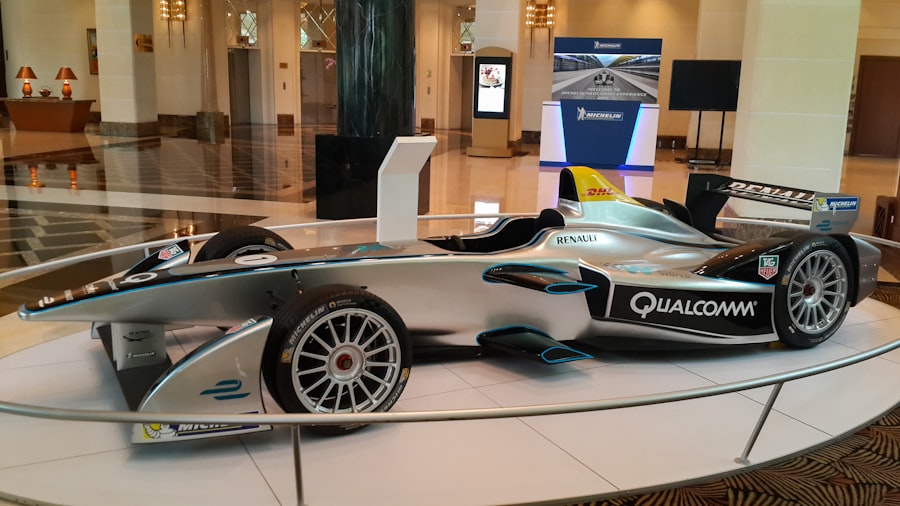Formula 1 (F1) is not merely a high-octane motorsport; it is a global phenomenon that intertwines speed, technology, and marketing prowess. The sport has evolved significantly since its inception in 1950, transforming into a multi-billion-dollar industry that captivates millions of fans worldwide. At the heart of this transformation lies a sophisticated marketing strategy that leverages the sport’s unique attributes to engage audiences, attract sponsors, and build enduring brand loyalty.
The marketing landscape of Formula 1 is characterized by its dynamic nature, where innovation and tradition coexist, creating a rich tapestry of promotional activities that resonate with diverse demographics. The marketing strategies employed in Formula 1 are as intricate as the engineering behind the cars themselves. With races held in iconic locations across the globe, F1 provides a unique platform for brands to showcase their products and services to a captive audience.
The sport’s ability to blend entertainment with cutting-edge technology offers marketers an unparalleled opportunity to connect with fans on multiple levels. From the glitz and glamour of race weekends to the intense competition on the track, Formula 1 marketing encapsulates a world where speed meets strategy, making it a fascinating case study for businesses looking to enhance their own marketing efforts.
Key Takeaways
- Formula 1 marketing leverages high-speed branding and global sponsorships to build a powerful, dynamic image.
- Social media and digital platforms play a crucial role in engaging fans and expanding the sport’s reach worldwide.
- Event marketing creates immersive experiences that deepen fan loyalty and enhance brand visibility.
- Data analytics enable targeted marketing strategies, optimizing fan engagement and commercial outcomes.
- Strategic partnerships and global expansion efforts help Formula 1 penetrate new markets and drive business growth.
Branding and Sponsorship in Formula 1
Branding in Formula 1 is a multifaceted endeavor that extends beyond mere logos on cars. It involves creating a narrative that resonates with fans and stakeholders alike. Teams like Ferrari and Mercedes have cultivated rich brand identities that evoke passion, heritage, and excellence.
The iconic prancing horse of Ferrari is not just a logo; it symbolizes decades of racing history and triumph. Similarly, Mercedes has positioned itself as a leader in both automotive engineering and motorsport, leveraging its success on the track to enhance its brand image in the consumer market. Sponsorship plays a pivotal role in the financial ecosystem of Formula 1.
Companies invest millions to have their brands associated with teams and drivers, seeking to capitalize on the sport’s global reach. For instance, Red Bull Racing has transformed its sponsorship model by integrating brands like Oracle and Tag Heuer into its identity, creating a symbiotic relationship where both parties benefit from increased visibility and prestige. The strategic placement of logos on cars, driver suits, and team merchandise ensures that sponsors gain maximum exposure during races, which are broadcasted to millions of viewers worldwide.
This symbiosis between teams and sponsors exemplifies how effective branding can elevate both parties in the competitive landscape of Formula 1.
Social Media and Digital Marketing in Formula 1

In the digital age, social media has become an indispensable tool for engaging fans and promoting brands within Formula 1. Teams and drivers utilize platforms like Twitter, Instagram, and TikTok to share behind-the-scenes content, race highlights, and personal stories that resonate with their audience. For example, Lewis Hamilton has amassed millions of followers on social media, using his platform not only to promote his racing career but also to advocate for social justice issues.
This personal connection fosters a sense of community among fans, who feel more invested in the personalities behind the helmets. Digital marketing strategies in Formula 1 extend beyond social media engagement. The sport has embraced innovative technologies such as augmented reality (AR) and virtual reality (VR) to enhance fan experiences.
For instance, F1 has developed mobile applications that allow fans to access real-time data during races, including telemetry information and driver statistics. This level of interactivity not only keeps fans engaged but also provides valuable insights into the sport’s intricacies. By leveraging digital platforms effectively, Formula 1 has created a vibrant online ecosystem that complements the excitement of race weekends and keeps fans connected year-round.
Event Marketing and Fan Engagement in Formula 1
| Metric | Description | Example Value | Relevance to Event Marketing & Fan Engagement |
|---|---|---|---|
| Event Attendance | Number of spectators attending a Formula 1 race event | 150,000 | Indicates the scale of live fan engagement and event popularity |
| Social Media Engagement | Likes, shares, comments, and mentions across platforms during race weekends | 5 million interactions | Measures online fan interaction and marketing reach |
| Fan Activation Participation | Number of fans participating in on-site activations and experiences | 20,000 | Shows effectiveness of experiential marketing efforts |
| Merchandise Sales | Units of official F1 merchandise sold during events | 30,000 units | Reflects fan investment and brand loyalty |
| TV Viewership | Number of viewers watching the race broadcast globally | 90 million | Indicates global reach and fanbase size |
| Mobile App Downloads | Downloads of the official Formula 1 app during race season | 1.2 million | Engages fans with real-time data and interactive content |
| Fan Demographics | Age and gender distribution of event attendees and followers | 60% male, 40% female; Avg. age 28 | Helps tailor marketing strategies to target audience |
| Brand Sponsorship Activation | Number of sponsor-led fan engagement activities at events | 15 activations per race | Enhances sponsor visibility and fan interaction |
Event marketing is at the core of Formula 1’s appeal, transforming each race into a grand spectacle that attracts fans from all walks of life. The atmosphere at a Grand Prix is electric, with fans experiencing not just the thrill of racing but also a festival-like environment filled with entertainment options, hospitality suites, and interactive exhibits. Teams often host fan engagement activities such as meet-and-greets with drivers, pit lane walks, and simulator experiences that allow fans to immerse themselves in the world of F1.
Moreover, Formula 1 has made significant strides in enhancing fan engagement through initiatives like F1 Fan Zone at various race locations. These zones offer interactive experiences where fans can participate in games, view live broadcasts, and enjoy merchandise stalls. The integration of technology into these events further amplifies fan engagement; for example, live polling during races allows fans to express their opinions on strategies or predict outcomes in real-time.
This two-way interaction not only enriches the spectator experience but also fosters a deeper connection between fans and the sport.
Data Analytics and Targeted Marketing in Formula 1
Data analytics has emerged as a cornerstone of modern marketing strategies within Formula 1. Teams collect vast amounts of data from various sources—ranging from telemetry data during races to fan behavior analytics on digital platforms. This wealth of information enables teams to make informed decisions about everything from race strategies to marketing campaigns.
For instance, by analyzing fan engagement metrics on social media, teams can tailor their content to better resonate with their audience, ensuring maximum impact. Targeted marketing efforts in Formula 1 are increasingly sophisticated due to advancements in data analytics. Brands can segment their audience based on demographics, interests, and behaviors, allowing for personalized marketing messages that speak directly to individual preferences.
For example, if data indicates that a particular demographic is more engaged with sustainability initiatives, teams can highlight their eco-friendly practices or partnerships with green technology companies in their marketing efforts. This level of precision not only enhances brand loyalty but also drives higher conversion rates as fans feel more connected to messages that align with their values.
Partnerships and Collaborations in Formula 1 Marketing

Partnerships are integral to the success of Formula 1 marketing strategies. Collaborations between teams and brands often lead to innovative campaigns that leverage each party’s strengths. For instance, partnerships with technology companies like IBM have enabled teams to utilize advanced analytics for performance optimization while simultaneously showcasing cutting-edge technology to fans.
These collaborations create a win-win scenario where both parties benefit from increased visibility and enhanced brand reputation. Moreover, cross-industry partnerships have become increasingly common in Formula 1 marketing. For example, collaborations with fashion brands or lifestyle companies allow teams to reach new audiences beyond traditional motorsport fans.
The partnership between Mercedes-AMG Petronas Formula One Team and Tommy Hilfiger exemplifies this trend; it merges high fashion with high performance, appealing to both motorsport enthusiasts and fashion-conscious consumers alike. Such collaborations not only broaden the reach of marketing efforts but also create unique brand narratives that resonate with diverse audiences.
Global Expansion and Market Penetration in Formula 1
The global expansion of Formula 1 has been a remarkable journey marked by strategic decisions aimed at penetrating new markets. The introduction of races in countries like Vietnam and Saudi Arabia reflects F1’s commitment to reaching untapped audiences while catering to local cultures and preferences. This expansion is not merely about geographical reach; it involves understanding regional dynamics and tailoring marketing strategies accordingly.
In addition to new race locations, Formula 1 has also focused on diversifying its fan base through initiatives aimed at increasing accessibility. The introduction of initiatives like F1 Academy seeks to engage younger audiences by providing educational resources about motorsport while promoting diversity within the sport itself. By fostering grassroots interest in regions where motorsport may not traditionally be popular, F1 is laying the groundwork for long-term growth and sustainability.
Lessons for Businesses from Formula 1 Marketing
The marketing strategies employed by Formula 1 offer valuable lessons for businesses across various industries. One key takeaway is the importance of building strong brand identities that resonate with consumers on an emotional level. Just as teams like Ferrari have cultivated rich narratives around their brands, businesses should strive to create compelling stories that connect with their target audience.
Additionally, the integration of technology into marketing efforts is crucial for staying relevant in today’s fast-paced environment. The use of data analytics for targeted marketing can significantly enhance customer engagement and drive sales. By understanding consumer behavior through data insights, businesses can tailor their offerings to meet specific needs effectively.
Finally, collaboration is essential for success in any industry. The partnerships formed within Formula 1 demonstrate how cross-industry collaborations can lead to innovative solutions that benefit all parties involved. By embracing partnerships and leveraging shared strengths, businesses can unlock new opportunities for growth and market penetration.
In summary, the world of Formula 1 marketing serves as an exemplary model for businesses seeking to enhance their own marketing strategies through branding, digital engagement, data analytics, partnerships, and global expansion efforts.



